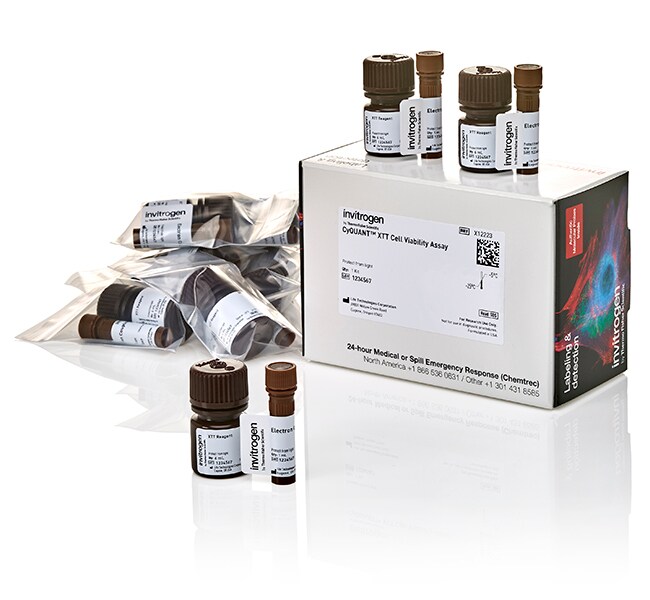Search Thermo Fisher Scientific

CyQUANT™ MTT and XTT Cell Viability Assays
| Catalog Number | Dye Type | Emission |
|---|---|---|
| X12223 | XTT | |
| V13154 | MTT |
CyQUANT MTT and XTT Cell Viability assays are colorimetric microplate assays used to measure the metabolic activity of cells, which is an indicator of cell viability, proliferation, and cytotoxicity. CyQUANT MTT and XTT function as cell health indicators by using the cellular redox potential of live cells to convert a tetrazolium-based salt reagent, MTT or XTT, to a brightly colored formazan product. The absorbance of the formazan can be measured using a microplate reader and correlates with the number of metabolically active cells to quantitively measure cell viability and proliferation.
Measuring cell viability is essential for assessing cell health, determining genotoxicity, and evaluating anti-cancer drugs. Colorimetric indicators such as MTT and XTT offer rapid, cost-effective, and consistent methods for quantitatively determining mammalian cell viability using microplate readers. The CyQUANT MTT assay is a well-established and popular cell viability assay, while the CyQUANT XTT assay provides a high dynamic range and low variability. In addition to improved performance, the CyQUANT XTT assay offers continuous measurement without the need for cell lysis or solubilization.
Features of the CyQUANT MTT Cell Viability Assay
- Complete and optimized MTT assay kit—includes all reagents needed for colorimetric detection of viable mammalian cells
- Trusted MTT reagent—uses the well-established MTT reagent to measure cellular redox potential
- Configured to perform 1,000 tests using a 96-well microplate
Principle of the CyQUANT MTT Cell Viability Assay
The CyQUANT MTT assay is based on the reduction of the water-soluble, yellow tetrazolium salt MTT (3-(4,5-dimethylthiazol-2-yl)-2,5-diphenyltetrazolium bromide) to insoluble, purple formazan crystals by metabolically active cells. The redox potential in the mitochondria of active mammalian cells reduces MTT to a strongly pigmented formazan product. After solubilization, the absorbance of the formazan can be measured on a microplate reader, which correlates with the number of metabolically active cells.
Protocol for the CyQUANT MTT Cell Viability Assay
Prepare the MTT reagent and incubate cells for a specific period, during which viable cells convert MTT into insoluble purple formazan product. The formazan crystals are then solubilized with the included SDS (sodium dodecyl sulfate) reagent or DMSO, and the absorbance is measured using a microplate reader at 570 nm.
Features of the CyQUANT XTT Cell Viability Assay
- High reproducibility—absorbance-based viability assay that measures redox potential in live cells with low variability
- Improved dynamic range and sensitivity—enhanced performance compared to other colorimetric viability assays
- Easy mix-and-read format—configured for one 96-well plate at a time
- Non-toxic and continuous—allows multiple time points to be collected without cell lysis
- Quick and simple—no solubilization step required, making it faster and easier to perform than the MTT assay
- Complete XTT assay kit—includes all the materials needed for ten 96-well plates
Principle of the CyQUANT XTT Cell Viability Assay
The CyQUANT XTT assay relies on the reduction of the water-soluble, yellow tetrazolium salt XTT (2,3-bis-(2-methoxy-4-nitro-5-sulfophenyl)-2H-tetrazolium-5-carboxanilide) to a water-soluble orange formazan product by metabolically active cells. Unlike MTT, XTT does not form insoluble crystals and produces a soluble formazan product that does not require solubilization. Since no cell lysis or solubilization are required for detection, the XTT assay can be used as a continuous assay, and multiple time points can be analyzed using an absorbance-based microplate reader.
In addition to the XTT Reagent, the CyQUANT XTT Cell Viability Assay kit includes electron coupling reagent to improve the dynamic range of the assay. The sensitivity and consistency of the assay is significantly increased when the electron coupling reagent is used with the CyQUANT XTT assay kit.
Protocol for the CyQUANT XTT Cell Viability Assay
For each 96-well plate, one bottle of XTT reagent and one tube of electron coupling reagent are thawed and mixed to create a stock solution, then added to cells. Cells are incubated for 2–4 hours, and metabolically active cells reduce XTT to form a water-soluble orange formazan dye. The absorbance of the dye is then measured using a microplate reader at 450 nm and 650 nm.
The XTT/electron coupling reagent stock solution should be used promptly after mixing, as extended room temperature storage or freeze/thaw cycles reduce assay performance and sensitivity. To ensure optimal performance and reproducibility, the CyQUANT XTT assay kit consists of separate XTT and electron coupling reagents that are mixed just prior to use.